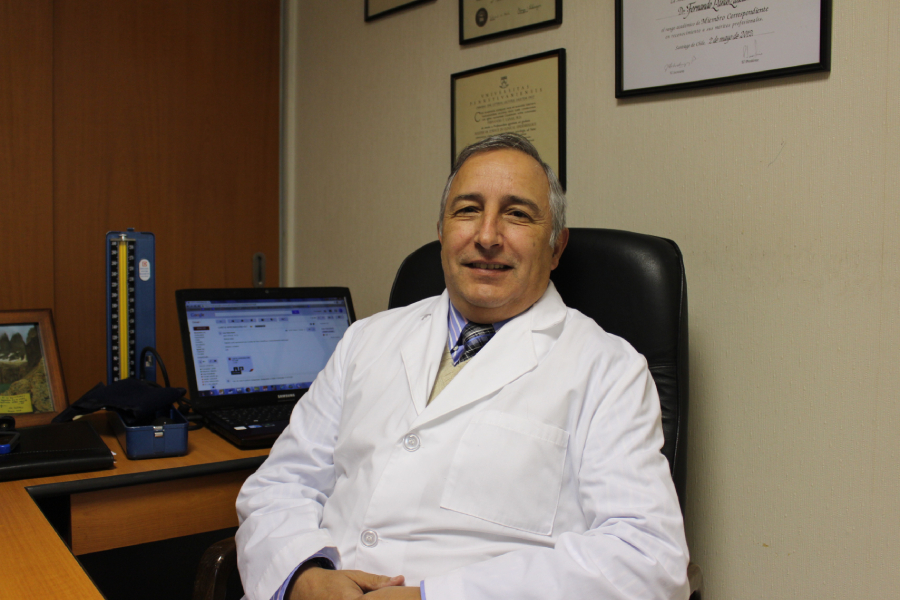|
The academic Dr. Fernando Lanas Zanetti of the Centre of Excellence in Training, Research and Management for Evidence-based Health (CIGES) and the Department of Internal Medicine, is part of the work group that will develop a general framework for the treatment of these two pathologies that are the leading cause of death in Chile and other parts of the world. |
The first meeting of the committee took place in New Orleans, with experts from different parts of the world and Dr. Fernando Lanas Zanetti as a representative of South America. The goal is to work together on a document that provides guidelines and a strategic framework for Ministries of Health all over the world, considering the conditions of the different countries. The academic Dr. Fernando Lanas Zanetti of the CIGES Centre of Excellence and the Department of Internal Medicine of the Faculty of Medicine of Universidad de La Frontera (UFRO), is part of this work group that will develop a general framework for the treatment of these two pathologies that are the leading cause of death in Chile and other parts of the world. In this context, it is worth mentioning that the World Health Organisation had a strong focus on preventive aspects, such as COVID-19 vaccines, the eradication of malaria and other infectious diseases, but also of chronic diseases, cardiovascular diseases and cancer. Other preventive aspects were campaigns against smoking or for the control of blood pressure, cholesterol and obesity, but this approach has changed. “The WHO realised that these measures were insufficient to meet the goal of decreasing the mortality from chronic diseases by 2030. That is why they decided to explore a new area for them, which is the treatment of heart attacks and strokes, which are the leading cause of death in Chile and other parts of the world,” commented Dr. Lanas. Thus, WHO set up a group of experts from different countries around the world to develop treatment strategies for acute coronary syndrome (pre-heart attack and heart attack) and strokes. After the first meeting, global experts and the WHO directors for chronic and cardiovascular diseases focused on the three critical areas of global failure. The first one is related to heart attacks, strokes and the medical capacity to unclog arteries. PREVALENCE OF HEART ATTACKS AND STROKES “The vast majority of heart attacks is caused by a complete or partial blockage of a heart artery, while strokes are mainly caused by a blood clot that blocks or narrows an artery leading to the brain. These blood clots can be destroyed with special intravenous medication or a catheter and a special balloon, but you have to act quickly, because once the artery is clogged, the neurons or heart muscle fibres begin to die and the more time you wait after the first symptoms, the more damage is done. After a certain lapse of time, it is not worth doing anything anymore, because there will only be dead cells left that will scar the person for life, if the person survives,” explained the cardiologist Dr. Lanas. That is why it is important to recognise the symptoms and to know what to do. Therefore, the different governments and their health services need to launch educational campaigns that make people more conscious about the presence of symptoms and that teach them about when to occur to a doctor. “The faster the better,” the cardiologist affirmed. The second aspect is to train the health teams, so they recognise when a heart attack or stroke is on the way. “First, you have to see the physical exam, which is an electrocardiogram that needs to be interpreted by a specialist. In Chile, we have an advanced online transmission system that transmits the data to a 24/7 central control centre in our capital city Santiago de Chile, where a cardiologist prepares an immediate report. If there are signs of a heart attack, the patient must be referred to an establishment where this procedure can be done – in Temuco, it is the public ‘Hospital Dr. Hernán Henríquez’ or the private clinic ‘Clínica Alemana’ – so the referral system has to be fast for patients who live more isolated. Another option is the use of thrombolytic medicine that dissolves the clots. They are available in all of our emergency services,” Dr. Lanas explained. The registry of the PURE project in Temuco shows that, currently, there are more strokes than heart attacks. Out of 100 heart attacks, 75 occur in men; women present fewer heart attacks and at a more advanced age. Strokes occur more evenly in men and women, on average 10 years after a heart attack. “A stroke is more complex than a heart attack, because the crucial exam is a brain scan, which is not available everywhere,” said Dr. Lanas. The third important aspect is to have a clear referral system that includes all health services, which is more complex for arterial procedures and brain scans. “We are advancing with that in Chile, but there are a lot of countries in the world that are not. We have access to thrombolytic drugs or other drugs such as aspirin or those that lower the cholesterol level. The WHO will work with the health ministries around the world to implement these measures and to see if we can reduce cardiovascular mortality by 30% by 2030,” concluded Dr. Lanas. In Chile, we already made a lot of progress regarding the aspects that are part of the strategic framework, although there are still a lot of details missing. The aim of the global strategy led by WHO, in which Dr. Fernando Lanas plays a leading role, is to make further progress, but in all countries in the world. Written by: Fabian Aguirre Silva |





